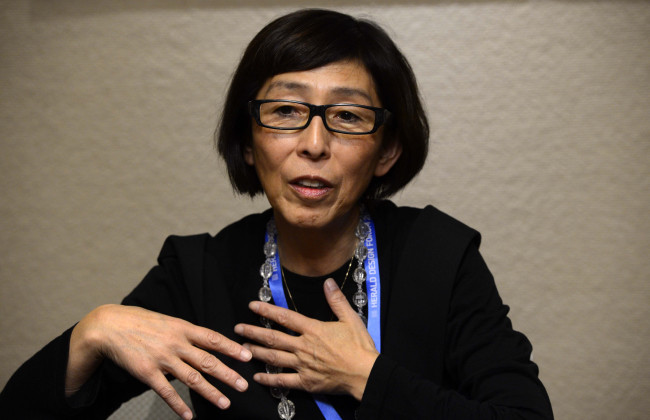[Herald Design Forum 2016] Believing in the power of space
By Korea HeraldPublished : Nov. 9, 2016 - 17:04
Throughout her career in a field dominated by men, award-winning architect Kazuyo Sejima has always recognized that good results stem from teamwork, rather than arbitrary division in the workplace.
“The key is to collaborate with lots of people, from engineers to users who experience architecture,” Sejima told The Korea Herald after speaking at the annual Herald Design Forum in Seoul on Tuesday. “Sometimes, there are conflicts and misunderstandings, but once (collaboration is) achieved, it’s a great joy to be able to share it with lots of people.”
This desire for harmony manifests itself in some of Sejima’s most renowned works, including the Louvre Lens in France, the New Museum of Contemporary Art in New York and the Almere Theatre and Art Centre in the Netherlands, among others.
Defined by their sleek and modern design, the Japanese architect’s projects rely heavily on glass to convey a connection between humans and the environment.
“Buildings should protect people, but they should also allow them to feel like they are a part of nature, even in the middle of the city,” she explained. “By avoiding isolation from nature, I try to achieve a building in which people would feel comfortable.”
However, working with glass comes with its own set of challenges, acting as “a barrier in some cases,” according to Sejima, the second woman to have been awarded the prestigious Pritzker Architecture Prize in 2010.
“When we use a big glass, it must be thick to be able to support itself, but small glass can be either thin or thick,” she said. “Balance is very important.”
“The key is to collaborate with lots of people, from engineers to users who experience architecture,” Sejima told The Korea Herald after speaking at the annual Herald Design Forum in Seoul on Tuesday. “Sometimes, there are conflicts and misunderstandings, but once (collaboration is) achieved, it’s a great joy to be able to share it with lots of people.”
This desire for harmony manifests itself in some of Sejima’s most renowned works, including the Louvre Lens in France, the New Museum of Contemporary Art in New York and the Almere Theatre and Art Centre in the Netherlands, among others.
Defined by their sleek and modern design, the Japanese architect’s projects rely heavily on glass to convey a connection between humans and the environment.
“Buildings should protect people, but they should also allow them to feel like they are a part of nature, even in the middle of the city,” she explained. “By avoiding isolation from nature, I try to achieve a building in which people would feel comfortable.”
However, working with glass comes with its own set of challenges, acting as “a barrier in some cases,” according to Sejima, the second woman to have been awarded the prestigious Pritzker Architecture Prize in 2010.
“When we use a big glass, it must be thick to be able to support itself, but small glass can be either thin or thick,” she said. “Balance is very important.”

Another role of glass in Sejima’s designs is its ability to bridge the gap between the often stark separation between the outside and the inside. It also allows for the spatial creativity often unattainable with walls.
“Division does not necessarily mean just outside versus inside,” she said. “Rather, I try to show a gradual connection between the interior and the exterior space by creating corridors and passageways.”
Sejima fears that recent technological advances and the rising cost of human labor are hindering creative innovations in Japanese architecture.
When submitting proposals for state-run projects, architects risk rejection if their plans stray too far from the status quo, she explained.
“Lots of building are being constructed using mass-produced units to reduce cost,” she said. “This is a huge problem.”
However, she remains hopeful.
“I believe space is a medium for communication,” said Sejima. “Young people have more possibilities to make and find new space to fit to the current situation,” she added.
By Kim Yu-young (ivykim@heraldcorp.com)
-
Articles by Korea Herald








![[Graphic News] More Koreans say they plan long-distance trips this year](http://res.heraldm.com/phpwas/restmb_idxmake.php?idx=644&simg=/content/image/2024/04/17/20240417050828_0.gif&u=)
![[KH Explains] Hyundai's full hybrid edge to pay off amid slow transition to pure EVs](http://res.heraldm.com/phpwas/restmb_idxmake.php?idx=644&simg=/content/image/2024/04/18/20240418050645_0.jpg&u=20240419100350)






![[From the Scene] Monks, Buddhists hail return of remains of Buddhas](http://res.heraldm.com/phpwas/restmb_idxmake.php?idx=652&simg=/content/image/2024/04/19/20240419050617_0.jpg&u=20240419175937)

![[KH Explains] Hyundai's full hybrid edge to pay off amid slow transition to pure EVs](http://res.heraldm.com/phpwas/restmb_idxmake.php?idx=652&simg=/content/image/2024/04/18/20240418050645_0.jpg&u=20240419100350)

![[Today’s K-pop] Illit drops debut single remix](http://res.heraldm.com/phpwas/restmb_idxmake.php?idx=642&simg=/content/image/2024/04/19/20240419050612_0.jpg&u=)